Mechanical Properties and Microstructure of Calcium Sulfate Whisker-Reinforced Cement-Based Composites
Abstract
:1. Introduction
2. Materials and Test Methods
2.1. Materials
2.2. Specimen Preparation
2.3. Test Methods
3. Results and Discussion
3.1. Basic Mechanical Properties
3.2. Fracture Properties
3.3. Shrinkage Properties
3.4. Capillary Water Absorption Properties
3.5. High-Temperature Residual Mechanical Properties
3.6. XRD and SEM Test
4. Conclusions
5. Future Work
Author Contributions
Funding
Institutional Review Board Statement
Informed Consent Statement
Data Availability Statement
Acknowledgments
Conflicts of Interest
References
- Goldmann, E.; Gorski, M.; Klemczak, B. Recent Advancement in Carbon Nano-Infused Cementitious Composites. Materials 2021, 14, 5176. [Google Scholar] [CrossRef]
- Cao, M.; Zhang, C.; Li, Y.; Wei, J. Using Calcium Carbonate Whisker in Hybrid Fiber-Reinforced Cementitious Composites. J. Mater. Civ. Eng. 2015, 27, 04014139. [Google Scholar] [CrossRef]
- Wan, L.; Pan, R.; Jun, X.U. Mechanical Properties and Microstructure of CaSO4 Whisker Reinforced Cement Mortar. J. Wuhan Univ. Technol.-Mater. Sci. Ed. 2019, 34, 1170–1176. [Google Scholar] [CrossRef]
- Dawood, E.T.; Ramli, M. High strength characteristics of cement mortar reinforced with hybrid fibres. Constr. Build. Mater. 2011, 25, 2240–2247. [Google Scholar] [CrossRef]
- Heikal, M.; Ismail, M.N.; Ibrahim, N.S. Physico-mechanical, microstructure characteristics and fire resistance of cement pastes containing Al2O3 nano-particles. Constr. Build. Mater. 2015, 91, 232–242. [Google Scholar] [CrossRef]
- Joshaghani, A.; Balapour, M.; Mashhadian, M.; Ozbakkaloglu, T. Effects of nano-TiO2, nano-Al2O3, and nano-Fe2O3 on rheology, mechanical and durability properties of self-consolidating concrete (SCC): An experimental study. Constr. Build. Mater. 2020, 245, 118444. [Google Scholar] [CrossRef]
- Hou, P.; Qian, J.; Cheng, X.; Shah, S.P. Effects of the pozzolanic reactivity of nanoSiO(2) on cement-based materials. Cem. Concr. Compos. 2015, 55, 250–258. [Google Scholar] [CrossRef]
- Ramezani, M.; Kim, Y.H.; Sun, Z. Mechanical Properties of Carbon Nanotube Reinforced Cementitious Materials: Database and Statistical Analysis. Mag. Concr. Res. 2019, 72, 1–62. [Google Scholar] [CrossRef]
- Luo, K.; Li, C.; Xiang, L.; Li, H.; Ning, P. Influence of temperature and solution composition on the formation of calcium sulfates. Particuology 2010, 8, 240–244. [Google Scholar] [CrossRef]
- Mao-Gang, L.I.; Kai, Y.E.; Luo, K.B.; Li, H.P.; Su, Y.; Li, G.B.; Mei, Y. Research Progress on Modification and Applications in the Material Fields of Calcium Sulfate Whisker. Bull. Chin. Ceram. Soc. 2017, 36, 1590–1593. [Google Scholar]
- Li, J.; Zhuang, X.; Querol, X.; Font, O.; Moreno, N. A review on the applications of coal combustion products in China. Int. Geol. Rev. 2018, 60, 671–716. [Google Scholar] [CrossRef]
- Yang, L.S.; Wang, X.; Zhu, X.F.; Du, L.Z. Preparation of Calcium Sulfate Whisker by Hydrothermal Method from Flue Gas Desulfurization (FGD) Gypsum. Appl. Mech. Mater. 2013, 268–270, 823–826. [Google Scholar] [CrossRef]
- Lin, M. Research on Preparation and Trans-Crystal Technology of α- Hemihydrate Flue Gas Desulfurization Gypsum with the Hydrothermal Method. Master’s Thesis, Chongqing University, Chongqing, China, 2009. (In Chinese with English abstract). [Google Scholar]
- Xiaoqin, W.; Shitang, T.; Baohong, G.; Zhongbiao, W.U. Transformation of Flue-Gas-Desulfurization Gypsum to (α-Hemihydrated Gypsum in Salt Solution at Atmospheric Pressure. Chin. J. Chem. Eng. 2011, 19, 349–355. [Google Scholar]
- Sun, H.; Tan, D.; Peng, T.; Liang, Y. Preparation of Calcium Sulfate Whisker by Atmospheric Acidification Method from Flue Gas Desulfurization Gypsum. Procedia Environ. Sci. 2016, 31, 621–626. [Google Scholar] [CrossRef] [Green Version]
- Yang, H.C.; Tsai, T.P. Microwave-Assisted Synthesis and Thermal Resistance of Calcium Sulfate Whiskers. Chem. Eng. Commun. 2017, 204, 232–237. [Google Scholar] [CrossRef]
- Deng, L.; Zhang, Y.; Chen, F.; Cao, S.; You, S.; Liu, Y.; Zhang, Y. Reactive Crystallization of Calcium Sulfate Dihydrate from Acidic Wastewater and Lime. Chin. J. Chem. Eng. 2013, 21, 1303–1312. [Google Scholar] [CrossRef]
- Pan, Q.; Chen, T.; Pan, R.; Liu, B.; Li, D. Mechanical Properties and Microstructure of Cementitious Materials Incorporated with Calcium Sulfate Whiskers and Silica Fume. Mater. Rep. 2019, 33, 257–263. [Google Scholar]
- Zhang, X.T.; Song, Q.; Wang, X.; Yang, L.S. Enhancement Performance of Desulfuration Gypsum Whisker on Cementitious Materials. Bull. Chin. Ceram. Soc. 2017, 36, 1298–1302. [Google Scholar]
- Li, X.; Li, L.; Zhang, C.; Zheng, Y. Experimental Study on Basic Mechanical Properties of Calcium Sulfate Whisker-Reinforced Cement. IOP Conf. Ser. Mater. Sci. Eng. 2020, 735, 012036. [Google Scholar] [CrossRef]
- Wang, K.; Geng, O.; Zhao, Y. Experimental study on working performance of calcium sulfate whisker recycled concrete. Concrete 2016, 5, 22–25. [Google Scholar]
- Zhang, D.; Geng, O.; Zhao, Y. Study on the Effects of Calcium Sulfate Whisker on Durability of Recycled Concrete. Concrete 2017, 2, 21–27. [Google Scholar]
- Sanjay, M.R.; Madhu, P.; Parameswaranpillai, J.; Siengchin, S.; Gorbatyuk, S. Advances in Bio-Based Fiber Moving Towards a Green Society; Elsevier: Amsterdam, The Netherlands, 2021. [Google Scholar]
- He, Y.; Wan, J.; Zhu, H.; Qu, X. Effects of Desulfurization Gypsum Whisker on Cement. Non-Met. Mines 2013, 36, 42–45. [Google Scholar]
- Cheng, X.; Dong, Q.; Li, Z.; Guo, X. High-temperature mechanical properties of CaSO4 whiskers reinforced high alumina cement. Mag. Concr. Res. 2018, 72, 1–61. [Google Scholar]
- Lou, C.; Xiao, Y.; He, D.; Yu, S.; Han, S.; Zhang, P. The Reinforcing Effect of Calcium-Based Whisker in High-Temperature Sand-Cement Mixtures. Pet. Drill. Tech. 2015, 43, 91–95. [Google Scholar]
- JGJ/T70-2009; Standard for Test Method of performance on Building Mortal. Shaanxi Provincial Academy of Building Research: Xi’an, China, 2009.
- Kequan, Y.; Wang, Y.; Yu, J.; Xu, S. A strain-hardening cementitious composites with the tensile capacity up to 8%. Constr. Build. Mater. 2017, 137, 410–419. [Google Scholar]
- Chen, W.; Qi, Z.; Zhang, L.; Huang, Z. Effects of cenosphere on the mechanical properties of cement-based composites. Constr. Build. Mater. 2020, 261, 120527. [Google Scholar] [CrossRef]
- ASTM C1585; Standard Test Method for Measurement of Rate of Absorption of Water by Hydraulic-Cement Concretes. ASTM International: Conshohocken, PA, USA, 2013.
- Cao, M.; Li, L.; Yin, H.; Ming, X. Microstructure and Strength of Calcium Carbonate (CaCO3) Whisker Reinforced Cement Paste After Exposed to High Temperatures. Fire Technol. 2019, 55, 1983–2003. [Google Scholar] [CrossRef]
- Kawashima, S.; Hou, P.; Corr, D.J.; Shah, S.P. Modification of cement-based materials with nanoparticles. Cem. Concr. Compos. 2016, 36, 8–15. [Google Scholar] [CrossRef] [Green Version]
- Sanchez, F.; Sobolev, K. Nanotechnology in concrete—A review. Constr. Build. Mater. 2010, 24, 2060–2071. [Google Scholar] [CrossRef]
- Nazari, A.; Riahi, S. The effects of SiO2 nanoparticles on physical and mechanical properties of high strength compacting concrete. Compos. Part B Eng. 2011, 42, 570–578. [Google Scholar] [CrossRef]
- Chen, W.; Huang, Z. Effect of Aggregates and Fiber Contents on Mechanical Properties and Microstructure of Light Toughness Cement-Based Composites (LTCC). Mater. Rep. 2020, 34, 18049–18055. [Google Scholar]
- Cao, M.; Cong, Z.; Lv, H.; Xu, L. Characterization of mechanical behavior and mechanism of calcium carbonate whisker-reinforced cement mortar. Constr. Build. Mater. 2014, 66, 89–97. [Google Scholar] [CrossRef]
- Fan, J.; Li, G.; Xiong, G.; Li, Q. Fracture Properties of Polyvinyl Alcohol Modified Cement Mortar. J. Build. Mater. 2016, 19, 336–341. [Google Scholar]
- Ma, X.; Liu, J.; Shi, C. A review on the use of LWA as an internal curing agent of high performance cement-based materials. Constr. Build. Mater. 2019, 218, 385–393. [Google Scholar] [CrossRef]
- Booshehrian, A.; Hosseini, P. Effect of nano-SiO2 particles on properties of cement mortar applicable for ferrocement elements. Mag. Concr. Res. 2011, 2, 167–180. [Google Scholar]
- Ehsani, A.; Nili, M.; Shaabani, K. Effect of nanosilica on the compressive strength development and water absorption properties of cement paste and concrete containing Fly Ash. Ksce J. Civ. Eng. 2016, 21, 1854–1865. [Google Scholar] [CrossRef]
- Yonggui, W.; Shuaipeng, L.; Hughes, P.; Yuhui, F. Mechanical properties and microstructure of basalt fibre and nano-silica reinforced recycled concrete after exposure to elevated temperatures. Constr. Build. Mater. 2020, 247, 118561. [Google Scholar] [CrossRef]
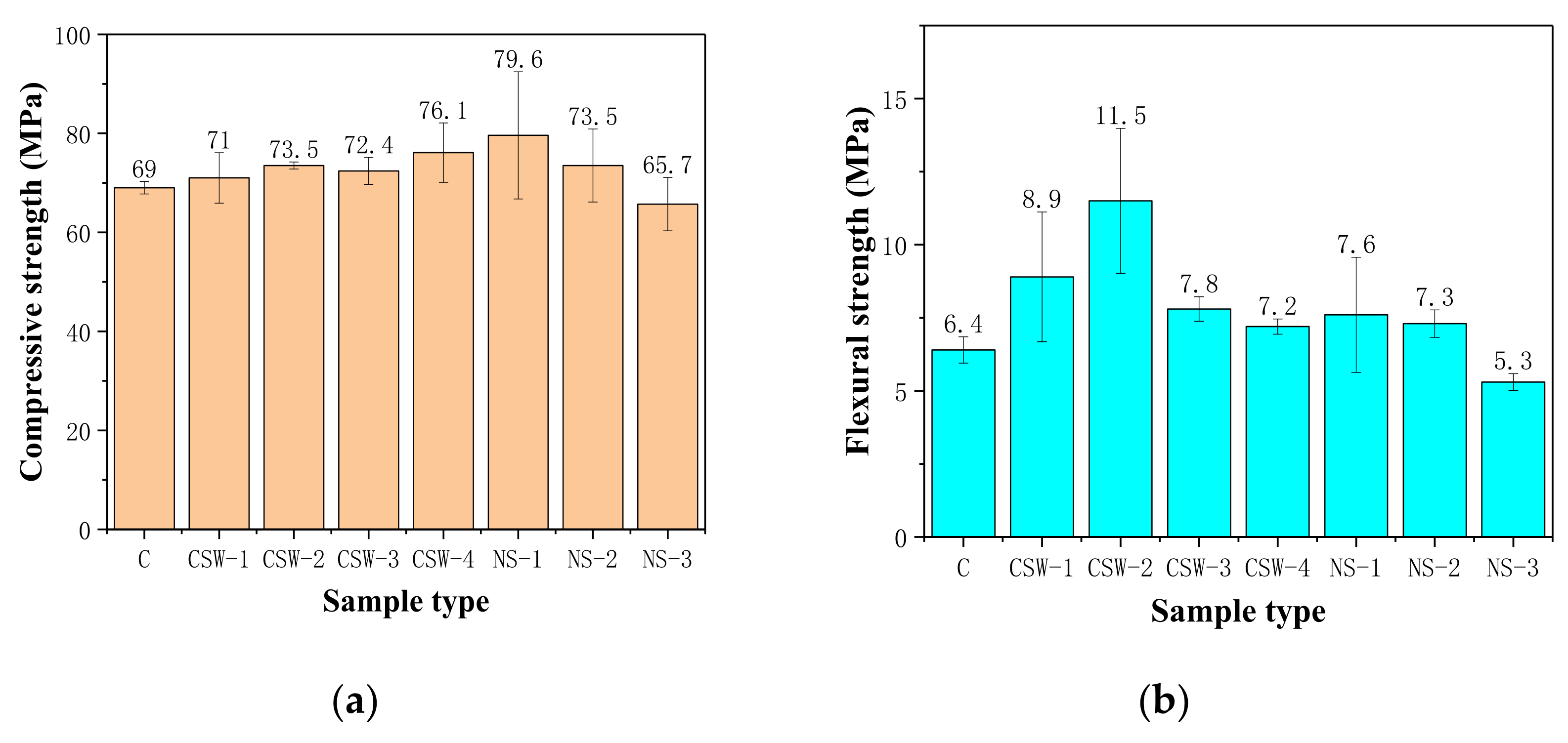
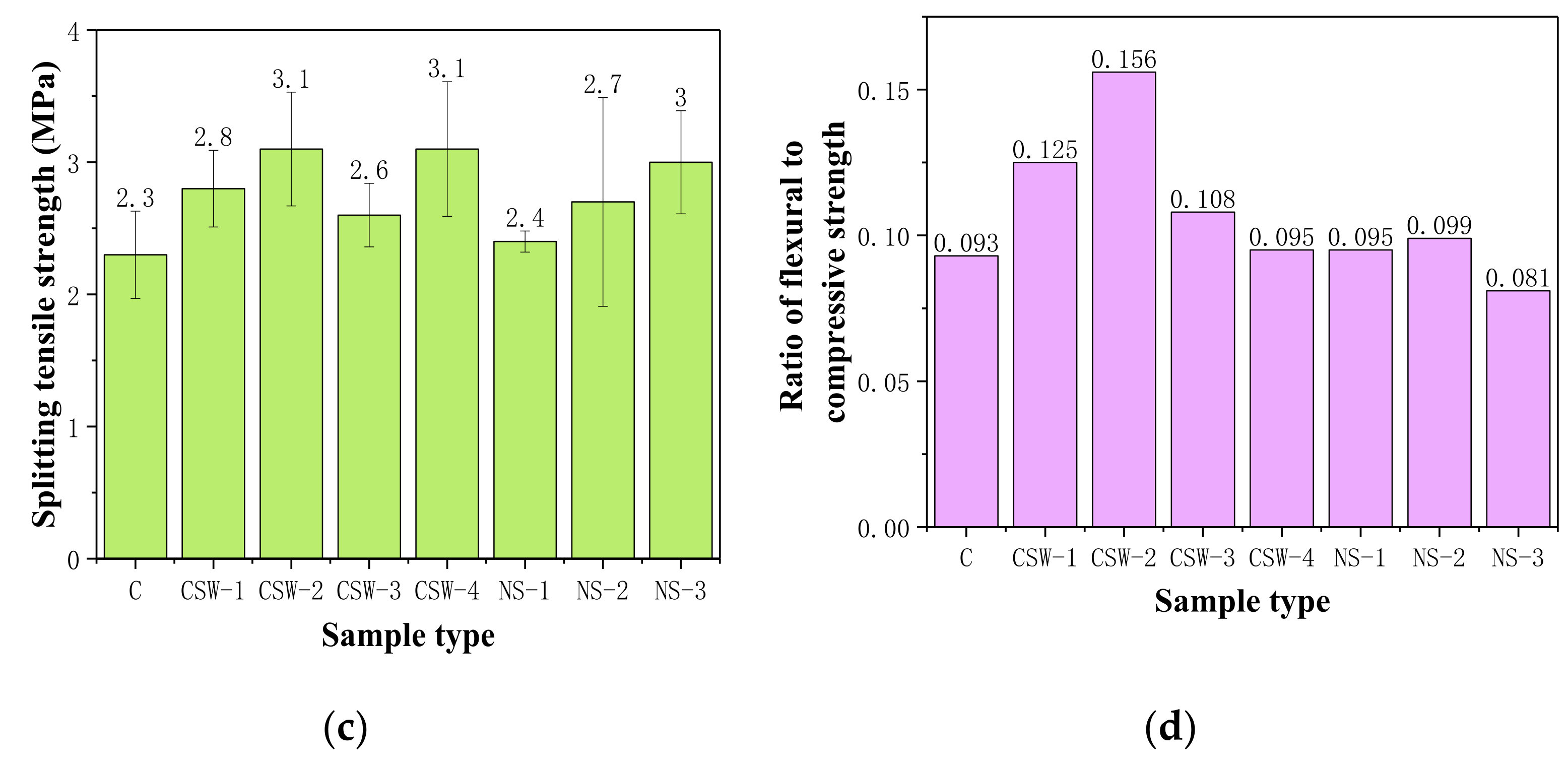
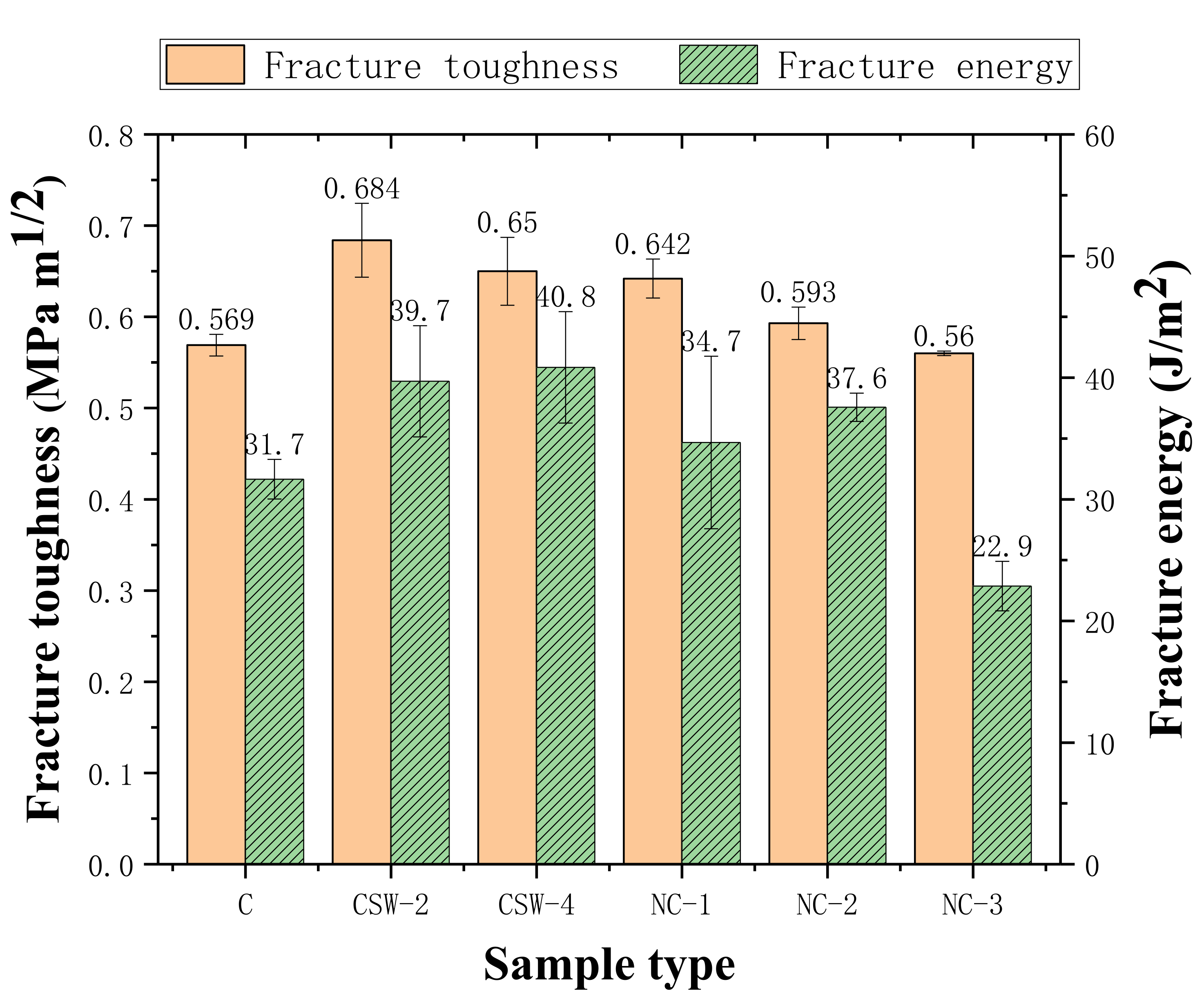


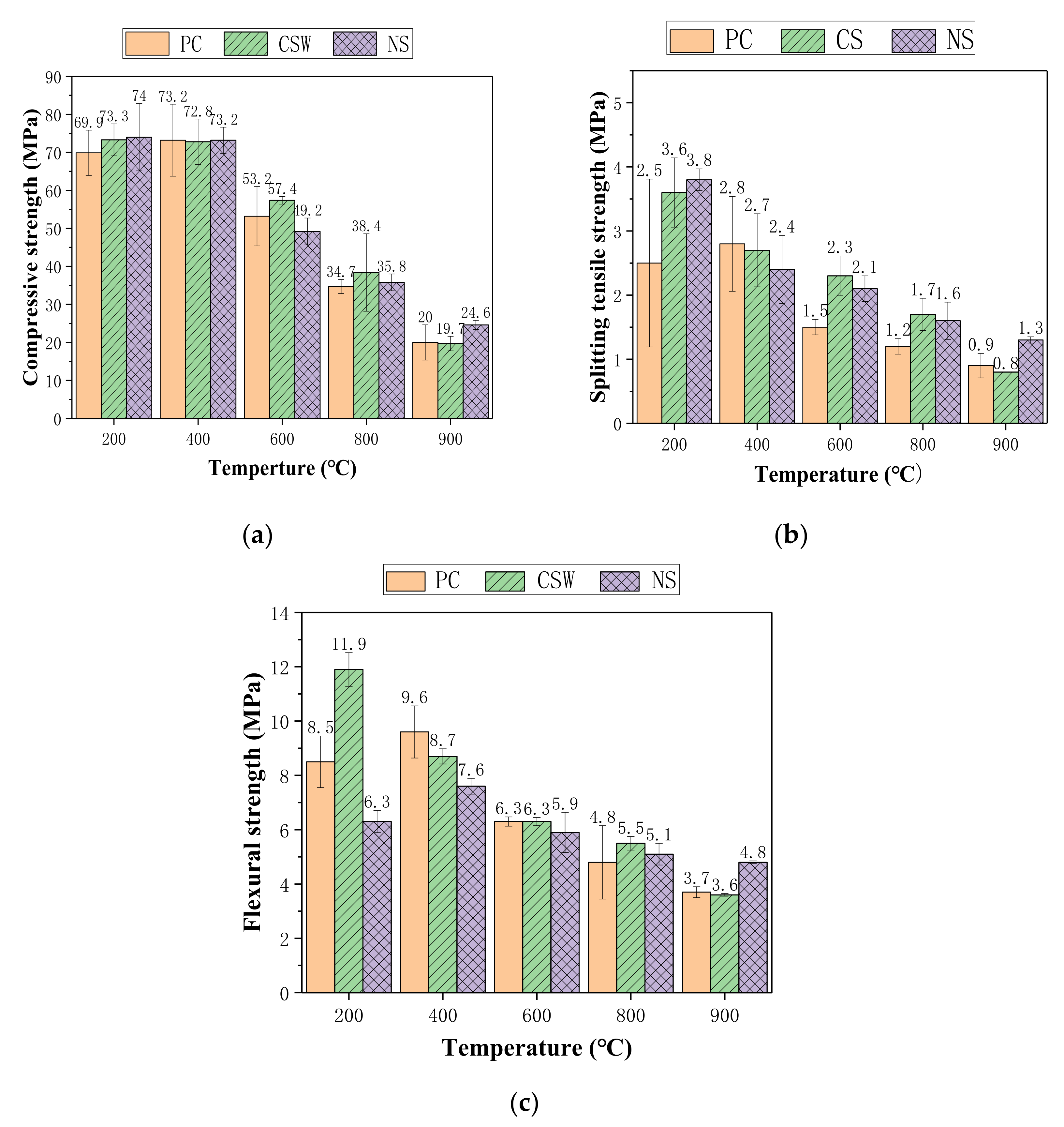
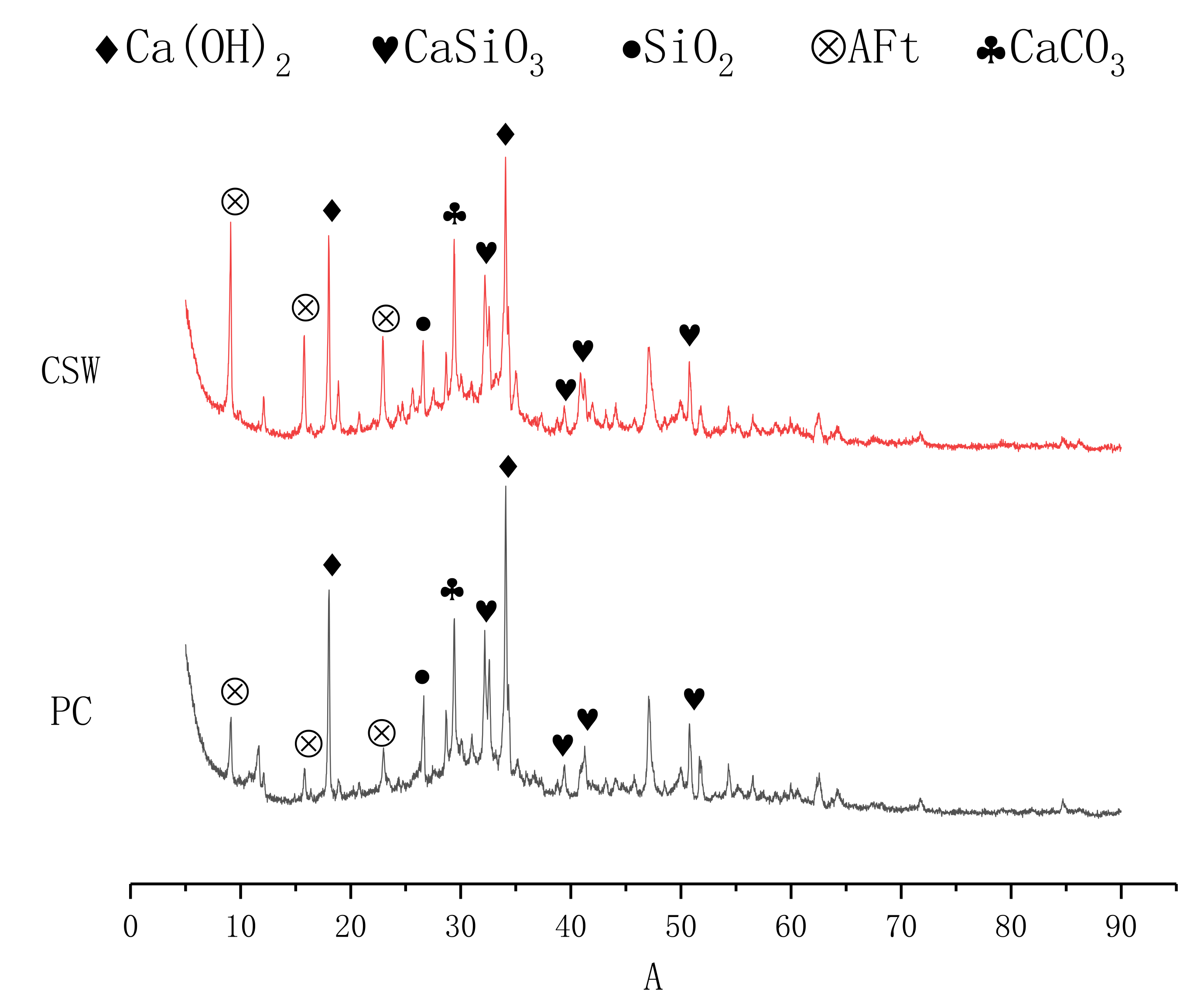


| Material | Length (μm) | Diameter (μm) | Moh’s Hardness | Density (g/cm3) |
|---|---|---|---|---|
| CSW | 10~50 | 1~5 | 3 | 2.69 |
| Material | Appearance | Particle Size (nm) | pH | Specific Surface Area (m2/g) |
|---|---|---|---|---|
| NS | White powder | 30 | 5–7 | 150–300 |
Publisher’s Note: MDPI stays neutral with regard to jurisdictional claims in published maps and institutional affiliations. |
© 2022 by the authors. Licensee MDPI, Basel, Switzerland. This article is an open access article distributed under the terms and conditions of the Creative Commons Attribution (CC BY) license (https://creativecommons.org/licenses/by/4.0/).
Share and Cite
Cao, K.; Liu, G.; Li, H.; Huang, Z. Mechanical Properties and Microstructure of Calcium Sulfate Whisker-Reinforced Cement-Based Composites. Materials 2022, 15, 947. https://doi.org/10.3390/ma15030947
Cao K, Liu G, Li H, Huang Z. Mechanical Properties and Microstructure of Calcium Sulfate Whisker-Reinforced Cement-Based Composites. Materials. 2022; 15(3):947. https://doi.org/10.3390/ma15030947
Chicago/Turabian StyleCao, Kai, Ganggui Liu, Hui Li, and Zhiyi Huang. 2022. "Mechanical Properties and Microstructure of Calcium Sulfate Whisker-Reinforced Cement-Based Composites" Materials 15, no. 3: 947. https://doi.org/10.3390/ma15030947





